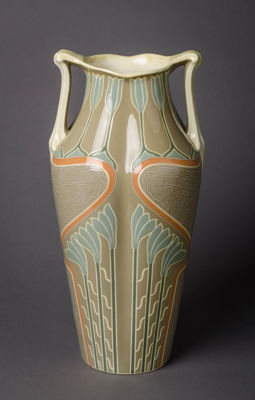Villeroy & Boch
The company began in the tiny Lorraine village of Audun le Tiche, where the iron master François Boch set up a pottery company with his three sons in 1748.[2] In 1766 Boch was licensed to build a ceramics kilnworks nearby at Septfontaines, Luxembourg, where it operated a porcelain factory. In 1785 Nicholas Villeroy became sole owner of the faience manufactory at Wallerfangen. In 1812 Jean-François Boch began construction of kilns at the nearby town of Mettlach, Saarland. In 1824 Boch commenced transfer printing on porcelain from engraved copper plates. On 14 April 1836, the Jean François Boch company merged with that of the competitor, Nicolas Villeroy, and became Villeroy & Boch, (V&B, also simply 'VB'). Since 1869, when Villeroy & Boch opened the first manufactory specializing in architectural tiles, the company has operated in three main areas, autonomous until 1982, tablewares, tiles for flooring and revetments, and fine plumbing fixtures. Among its innovations in Mettlach at the end of the nineteenth century.was Phanolith, a kind of semi-transparent porcelain that combines the characteristics and benefits of jasperware and pate-sur-pate.[3] The creator of the Phanolith was the ceramics artist Jean-Baptiste Stahl, who headed the modelling section of Villeroy & Boch. Phanolith gained first wide public attention at the Paris Exposition Universelle (1900). Villeroy & Boch has continued to base its broadest market in Germany.
Sort by
Display per page
Title: Large Vase with Tulips
Artist: Villeroy & Boch
Beautiful and colourfully glazed large vase designed and thrown around the turn of the 20th century, the motif depicting tulips in the Art Nouveau style particularly popular during that time. Viceroy & Boch often combined the contemporary surface design with classical silhouettes in a particularly visually pleasing marriage, the ceramics manufacturer appealing to its largely German market with several advancements and new forms of technique at this time. Large two-handled vase


